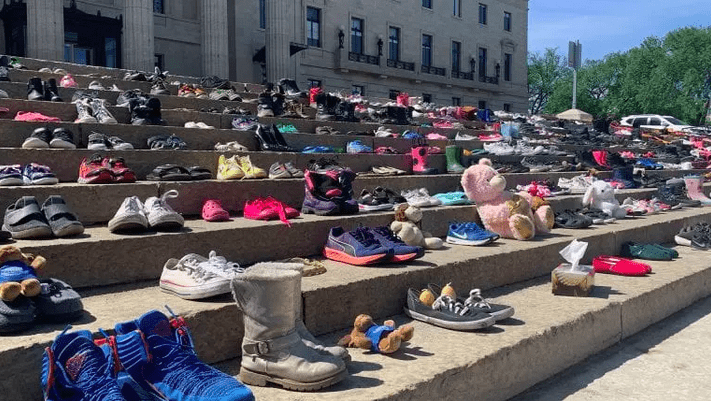Canada’s National Trauma and the Power of Indigenous Survival

Shoes on the steps of the Manitoba Legislature/Michelle Karlenzig/APTN
Carol Anne Hilton
June 4, 2021
Close your eyes.
Take a moment to pause and reflect. Canada’s reality and identity have been severely shaken this week over the discovery of the remains of 215 children at the Kamloops Indian Residential school. We are all searching for words and meaning, grappling with a national history built on the shaky foundation of a false origin story. This atrocity has shaken us to the core.
I turn our collective attention to the cellular highway or pathway of Canadian identity. The response to this story has been visceral, with feelings of grief, dismay, pain and sadness dominating. The neural networks of Indigenous and non-Indigenous personhood are all firing trauma. The residential school survivors, those closest in proximity to this trauma, are haunted with memories and flashbacks coming to the surface-triggering the trauma story that has founded and shaped Canada itself.
Canada was created through the lens of the “Indian problem” of Indigenous existence. The response to the Indian problem was the grand design of the destruction of the Indigenous population. The story of residential schools was one of design. The finding this week has unveiled the true nature of this destruction. Canada faces a design issue and an accountability question in response. This was and always has been a policy issue and definitely economic in nature.
Addressing the Indian problem was carried out in three steps driving the economic, religious and political agendas. The first step was severance, essentially cutting the ties of identity across generations through the residential schools. The second step was displacement of the Indigenous populations through the establishment of the reserve systems. The third step was economic disorientation through the development of the Indian Act. This, over time, reinforced the transformation of the Indian problem into a new form to be expressed as the socioeconomic gap or the Indigenous cost or burden to the national financial system.
With the truth out in the open for the world to see, we are now at the intersection where the cost of doing nothing is in direct opposition to building a future of this country that addresses this atrocity. With this coming into our national awareness right now, it has served to highlight the invisibility of the Indian residential school experience and brings into sharp focus the systems and structure of genocide in this country and the need for an appropriate response today.
To date, reconciliation efforts can be likened to meandering around base camp at the bottom of the mountain. Canada has spent $3.2 million fighting St Anne’s in court. Fighting residential school survivors in court is not reconciliation. It is time to climb the mountain.
The Truth and Reconciliation Commission’s Calls to Action were shaped from the stories of the lived reality of the trauma of those who made it out of the residential schools. The children who did not make it out alive are revealing the uncomfortable truth today. This story has laid bare the bones of the broken truths of the identity of Canada itself. The cold, dark realities of the structures of genocide are now entrenched within Canadian identity, no longer deniable nor invisible.
In the words of Commissioner Murray Sinclair upon the release of the Truth and Reconciliation report, “We have described for you a mountain. We have shown you a path to the top. We call upon you to do the climbing.” The recommendations serve as a call to action not only for the government but for all Canadian citizens. The only appropriate response is for the federal and provincial governments to take serious steps to implement the 94 Calls to Action outlined in the Truth and Reconciliation Commission’s final report, in particular Calls to Action 71-76 involving missing children and burial information. To date, reconciliation efforts can be likened to meandering around base camp at the bottom of the mountain. Canada has spent $3.2 million fighting St Anne’s in court. Fighting residential school survivors in court is not reconciliation. It is time to climb the mountain.
I am the first generation out of the residential school system — this is both a responsibility and an inspiration. My parents and grandparents went to residential schools. They were tortured and broken and lived a pathway of destruction. The trauma, articulated as alcoholism, violence and separation, further expressed itself across generations.
I am often asked what inspires me in my work in building Indigenomics. Indigenomics is re-imagining another future. It is a response to the generations of trauma: to choose to see our resilience and strength. Indigenomics is choosing to see Indigenous peoples as powerful for surviving what was an industrialized effort to obliterate us. Indigenomics and the $100 billion Indigenous economy is definitely personal. It is my response.
In 2019, when the Indigenomics Institute unveiled the 100 billion-dollar national Indigenous economic target at the Assembly of First Nations Special Chiefs meeting in Ottawa, the final sentence of the presentation was “Every time we say ‘100 billion-dollar Indigenous economy’ it reawakens the Indian in the child that John A. Macdonald tried to kill.” Is Canada ready for this sentence? It’s time to get ready. This isn’t something to ‘get over.’ We all collectively need to heal this trauma story. Let’s have the courage to do this together.
Carol Anne Hilton, a member of the Hesquiaht First Nation, is the founder and CEO of the Indigenomics Institute.
